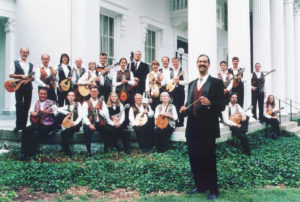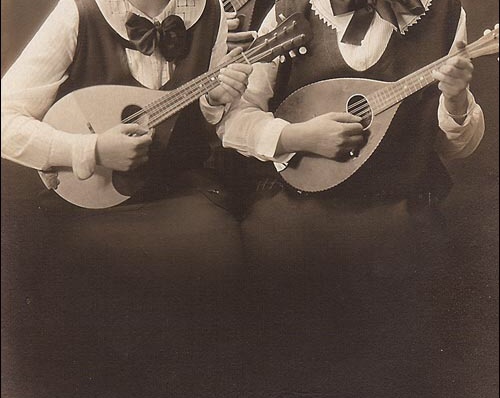
by Rick Mattingly
Louisville Magazine
To some folks, the name Louisville Mandolin Orchestra might sound like the moniker for a giant bluegrass band. But the bluegrass style doesn’t encompass the history and versatility of the mandolin any more than bluegrass fiddling represents the totality of the violin. “The mandolin originated in Italy within the folk-music and classical traditions, and mandolin is very popular in Europe,” says Jim Bates, the 28 member Louisville Mandolin Orchestra’s affable conductor. “Germany alone has well over 2,000 mandolin orchestras, which is kind of hard to fathom in this country.” But mandolin orchestras exist in a number of U.S. cities, and many have been going since the early 1900s. Although, at only 10 years of age, the Louisville Mandolin Orchestra is “right out of the cradle,” as LMO president Joe Burch puts it, the mandolin orchestra tradition in Louisville dates back at least a century.

“Before Mike Schroeder founded the Louisville Mandolin Orchestra in 1988, he did some research and uncovered evidence that there were seven or eight mandolin orchestras in Louisville in the 1890s,” Bates says. “I’m a doctoral candidate in musicology at U of L, and I did a paper recently on the mandolin orchestra tradition in Louisville. In the process, I met (Courier-Journal deputy managing editor) Bill Ellison, who had researched a Louisville composer named John Mason Strauss. Strauss had been a member of the Louisville Mandolin and Guitar Club, which was probably the most well known of the local mandolin orchestras.
“That group had a pretty colorful existence,” Bates says with a mixture of amusement and awe. “They were all over the place in the region, playing concerts as well as serenading girls outside their windows. Reportedly, women threw them all kinds of notes, scarves and gloves. Every June, to mark their anniversary, they played a (river boat) concert floating down the Ohio river, and it was one of the social events of the summer season.”
The Louisville Mandolin and Guitar Club also got quite a bit of local newspaper coverage, no doubt enticed by the inclusion of their programs of “The Louisville Times Newspaper March,” a piece composed by Strauss. The original mandolin orchestra arrangement of that Piece was lost, but Bates secured a piano arrangement and adapted it for the Louisville Mandolin Orchestra, which has performed it at the Filson Club.
Original pieces that have been composed for the Louisville Mandolin Orchestra include The Louisville Suite by former LMO member John Goodin, which includes “Up River Road,” “Cave Hill” and “Locust Grove.” The group also inspired Sinfonietta by A. Paul Johnson, a National Endowment for the Arts composer who discovered the LMO while living in Bardstown a few years ago.
“Paul came to one of our rehearsals, and a couple of weeks later we had a three-movement composition,” Bates says. “We recorded it for a CD compilation of his works. He now lives in the St. Petersburg area. The Florida Arts Council heard the CD and really loved the piece he wrote for us, and they’ve nominated it for a Pulitzer Prize.
The scope of the group’s repertoire is evident on its self-produced CD, FolkWorks, which features a Russian “Balalaika Medley,” “Ten Pieces for Children” by Hungarian composer Bela Bartok, an “Irish Folk Suite” and a “Stephen Foster Medley.” The CD is available locally at ear-X-tacy stores and at Disc Jockey Records on Shelbyville Road. The Louisville Mandolin Orchestra also appears on five tracks of a CD titled The New York Times, featuring marches dedicated to American Newspapers. (Ironically, “The Louisville Times Newspaper March” is not included.) The CD was produced by The Advocate-Messenger in Danville, Ky.
With its basic instrumentation of first and second mandolins, mandolas, mandocellos, guitar and bass, the LMO functions much like a traditional string orchestra, except that the plucked instruments give the group a somewhat brittle staccato sound.
“We’re like a giant harpsichord, played by 20 hands,” Bates says, laughing.
“Compared to the European mandolin orchestras, we do have a different sound,” adds Burch. “They use round-back, classical-style instruments, whereas we use mostly American flat-back mandolins, which are brighter and punchier sounding. Also, we use steel-string guitars, but in Europe they use nylon-string guitars. And we’ve introduced other instruments into the group on occasion, including harp, accordion, banjo, violin and pennywhistle.”
Members of the group have a variety of musical backgrounds. Some, like Schroeder, started as bluegrass players and were drawn into classical mandolin as a way of expanding their knowledge of the instrument. Others started out as violin, viola and cello players who easily made the transition to mandolin, mandola and mandocello, as the tunings are identical. “One thing that’s different about our orchestra than some of the others is that our median age is much younger,” Bates says. “We have young adults, and even high school kids who also play in the Louisville Youth Orchestra. So that gives our group a lot of energy.”
Since their debut at the “Mando Magnificat” concert, presented as part of the Lonesome Pine Special series at the Kentucky Center for the Arts in October 1988, the Louisville Mandolin Orchestra has performed about four times a year, including three trips to Europe, but the group doesn’t announce a formal concert schedule. Quartets and quintets composed of LMO members often perform at weddings, parties and neighborhood festivals.
Watching the group rehearse in Burch’s garage on a recent Saturday morning, it was obvious that the members strive for excellence in their performance. But it was also apparent that everyone was having a good time playing music together, and a “club” atmosphere prevailed.
“We have an open-door policy,” Bates says. “Anyone who is enthusiastic about the mandolin and loves to play music is welcome to join.”
“I’m about the only one in the group who does music for a living,” says Bates, who is music director of the Louisville Youth Orchestra and teaches bass and music history at U of L’s School of Music. “Besides representing the mandolin orchestra tradition, we also represent a great tradition of amateur music-making in America.”
© 1998, Louisville Magazine


